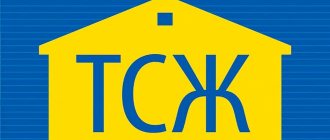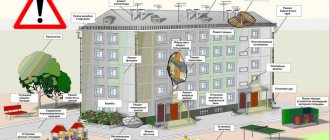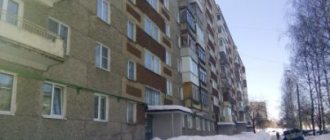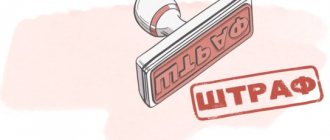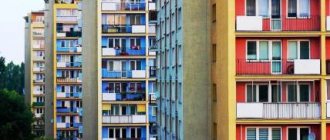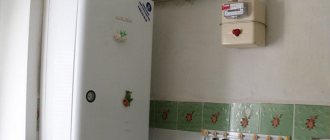(Slide 2) The emergence of the right to common property in MKD
The issue of common property, starting from 1995, was resolved in the Civil Code of the Russian Federation (Civil Code of the Russian Federation). Articles 289, 290 of the Civil Code of the Russian Federation indicated that the owner of an apartment in an apartment building, along with the premises occupied by him as an apartment, also owns a share in the ownership of the common property of the house.
The owners of premises in a residential building became owners of the common property of the house simultaneously with the acquisition of the status of owner, which arose from the moment of registration of ownership rights as a result of the privatization of an apartment or another transaction for its acquisition (for example, as a result of participation in shared construction, purchase, gift, etc. .).
The Civil Code established an important principle for the emergence of rights to common property: these rights are not subject to separate registration, but follow the fate of the fundamental right - the right to residential/non-residential premises in the house.
Characteristic features of common shared ownership of real estate:
- inability to allocate shares in kind;
- the impossibility of alienating a share in the right of common ownership separately from residential/non-residential premises;
- a share cannot exist independently; it is an integral part of residential/non-residential premises as an object of ownership, and therefore always follows the fate of such premises.
(Slide 3) Composition of common property in MKD
The common property in an apartment building includes:
- landings, stairs, elevators are classified as common property, since they are intended for the passage (or passage) of all owners to their apartments;
- The place where the elevator is located is called the elevator shaft. In addition to this, the house may have a ventilation shaft - it is also considered common property;
- technical floor (needed for placing engineering equipment and laying communications); it can be located in the lower (technical underground), upper (technical attic) or in the middle part of the building;
- Some apartment buildings have premises designed to meet the social and living needs of residents. These are wheelchairs, recreation rooms, gyms, dance classes - of course, if all residents can use them. If someone bought two apartments in your building on the ground floor and converted them into a paid gym, these premises are not common property - they have their own owner;
- the roof is also considered community property. In housing terminology, it is defined as “the upper enclosing structure of a building that performs load-bearing, waterproofing and thermal insulation functions”;
- enclosing load-bearing and non-load-bearing structures of the house. First of all, these include walls. In addition, in accordance with this principle, the balcony slab is included in the common property. It should be understood that as part of the balcony, it is the slab that belongs to the common property. The owner carries out the maintenance of the parapet, the glazed part of the balcony and the canopy independently, since this is his personal property;
- the technical basement also belongs to the common property of all owners of premises in an apartment building, since it serves for ventilation of the underground space under the premises of the first floor, as well as for the placement of engineering equipment and utility networks of the house;
- a land plot is an area intended for the operation and maintenance of an apartment building. On the land plot there is a house, improvement elements and other objects intended for the maintenance, operation and improvement of this house;
Landscaping elements include, for example, areas for drying clothes, cleaning clothes, carpets and household items; recreation areas for adults; children's playgrounds and sports grounds with landscaping and necessary equipment for children's summer and winter recreation.
This composition is defined in more detail in the Decree of the Government of the Russian Federation dated August 13, 2006 No. 491 “On approval of the Rules for the maintenance of common property in an apartment building and the rules for changing the amount of fees for the maintenance and repair of residential premises in the case of the provision of services and performance of work on the management, maintenance and repair of common property in an apartment building of inadequate quality and (or) with interruptions exceeding the established duration" (hereinafter referred to as Rules No. 491).
When determining the composition of common property, information on rights to real estate objects that are common property contained in the Unified State Register of Rights to Real Estate and Transactions with It (hereinafter referred to as the Register), as well as information contained in the state land cadastre, is used.
In the event of a discrepancy (contradiction) in information about the composition of common property contained in the Register, documentation of state technical accounting, accounting of managers or other organizations, technical documentation for apartment buildings, the information contained in the Register takes precedence.
(Slide 4) Rules for maintaining common property in apartment buildings
!!! In accordance with clause 10 of Rules No. 491, common property must be maintained in accordance with the requirements of the legislation of the Russian Federation (including on the sanitary and epidemiological welfare of the population, technical regulation, consumer protection) in a condition that ensures:
- compliance with the reliability and safety characteristics of an apartment building;
- safety for the life and health of citizens, safety of property of individuals or legal entities, state, municipal and other property;
- availability of use of residential and (or) non-residential premises, common areas, as well as the land plot on which the apartment building is located;
- compliance with the rights and legitimate interests of premises owners, as well as other persons;
- constant readiness of utilities, metering devices and other equipment included in the common property for the provision of utilities (supply of utility resources) to citizens living in an apartment building, in accordance with the Rules for the provision of utility services to citizens;
- maintaining the architectural appearance of an apartment building in accordance with the design documentation for the construction or reconstruction of an apartment building;
- compliance with the requirements of the legislation of the Russian Federation on energy saving and increasing energy efficiency.
The maintenance of common property, depending on the composition, design features, degree of physical wear and tear and technical condition of the common property, as well as depending on the geodetic and climatic conditions of the location of the apartment building, includes:
- inspection of common property carried out by the owners of premises, ensuring timely identification of non-compliance of the condition of common property with the requirements of the legislation of the Russian Federation, as well as threats to the safety of life and health of citizens;
- ensuring the readiness of in-house engineering power supply systems and electrical equipment that are part of the common property to provide public electricity supply services;
- maintaining the premises that are part of the common property in a condition that ensures the temperature and humidity in such premises established by the legislation of the Russian Federation;
- cleaning and sanitary cleaning of common areas, as well as the land plot included in the common property;
- collection and removal of solid and liquid household waste, including waste generated as a result of the activities of organizations and individual entrepreneurs using non-residential (built-in and attached) premises in the apartment building;
- maintenance and care of landscaping and landscaping elements, as well as other objects intended for the maintenance, operation and improvement of this apartment building located on a land plot that is part of the common property;
- current and major repairs, preparation for seasonal operation and maintenance of common property,
- carrying out mandatory energy saving and energy efficiency measures in relation to common property, included in the list of measures approved in accordance with the procedure established by the legislation of the Russian Federation;
- ensuring the installation and commissioning of collective (common house) metering devices for cold and hot water, thermal and electrical energy, natural gas, as well as their proper operation (inspections, maintenance, verification of metering devices, etc.).
The minimum list of services and work necessary to ensure the proper maintenance of common property in an apartment building, and the Rules for the provision of services and performance of work necessary to ensure the proper maintenance of common property in an apartment building, are established by the Government of the Russian Federation in Decree dated April 3, 2013 No. 290 and includes into yourself:
- work necessary for the proper maintenance of load-bearing structures (foundations, walls, columns and pillars, floors and coverings, beams, crossbars, stairs, load-bearing elements of roofs) and non-load-bearing structures (partitions, interior decoration, floors) of apartment buildings;
- work necessary for the proper maintenance of equipment and engineering support systems that are part of the common property in an apartment building;
- works and services for the maintenance of other common property in an apartment building (dry and wet cleaning of common property, disinfection, deratization of premises).
!!! In accordance with clause 15 of Rules No. 491, the scope of work does not include:
- maintenance and repair of doors to apartments, doors and windows located inside residential or non-residential premises that are not common areas;
- insulation of window and balcony openings, replacement of broken glass windows and balcony doors, insulation of entrance doors in apartments and non-residential premises that are not common areas;
- cleaning and cleaning of land plots that are not part of the common property, as well as landscaping and care of landscaping elements (including lawns, flower beds, trees and shrubs) located on land plots that are not part of the common property. These actions are carried out by the owners of the relevant land plots.
(Slide 5) Expenses of premises owners in apartment buildings
The Housing Code states that the owner of premises in an apartment building is obliged to bear the costs of maintaining housing, as well as to participate in the costs of maintaining common property in the house in proportion to his share in the right of common ownership of this property by paying fees for the maintenance of residential premises and contributions for major repairs.
Expenses for the maintenance and repair of residential/non-residential premises are determined in an amount that ensures the maintenance of common property in accordance with the requirements of the legislation of the Russian Federation. They include:
- expenses for the maintenance and repair of in-house engineering systems of electricity, heat, gas and water supply, drainage,
- reasonable expenses for collection of debts for payment of residential premises and utilities,
- expenses for taking meter readings,
- costs of maintaining information systems that ensure the collection, processing and storage of data on payments for residential premises and utilities, issuing payment documents for payment of residential premises and utilities.
If the owners at their general meeting did not decide to establish the amount of payment for the maintenance of residential premises, such amount is established by the local government body.
More detailed information on how owners must pay for services for the maintenance and repair of common property in an apartment building, depending on the form of management of the house, is prescribed in Rules No. 491.
For example, when determining the amount of payment for the maintenance and repair of residential premises of the owners of premises who have chosen a management organization, the decision of the general meeting of owners of premises in such a house is made for a period of at least one year, taking into account the proposals of the management organization. The specified fee amount is set the same for all owners of premises.
Expenses for major repairs of common property in apartment buildings are financed from the capital repair fund and other sources not prohibited by law. In the Stavropol Territory, the minimum contribution for major repairs is set at 6.36 rubles. per square meter. It may be higher if such a decision was made at a general meeting of the owners of the house.
The obligation to pay the costs of major repairs of an apartment building applies to all owners of premises in this house from the moment the ownership of the premises in this house arises. When ownership of premises in an apartment building is transferred to the new owner, the previous owner’s obligation to pay the costs of major repairs, including his existing debt, also passes.
Thank you for your attention!
In the next lesson we will look at the topic
“Quality control of public services
Responsibility of the management company
Control over the proper maintenance of common property, as well as the correct expenditure of citizens’ funds, lies with the housing supervision authorities of the region. Typically, residents, being dissatisfied with the quality of the services provided, do not contact the housing inspectorate or the prosecutor's office immediately, but only after they have not found a common language with the management company.
Each of the owners of apartments in an apartment building has the right to contact the management company in order to obtain complete information about the list of services performed, as well as about those third-party organizations that were hired by the management company.
Residents also have the right to familiarize themselves with the cost of services performed and, by sending a request, express disagreement with the price under the contract or with the level of quality of certain works. The management company is obliged to provide any resident with information about the expenditure of funds within 5 working days from the date of application.
Residents have the right to control the activities of the management company and even order an examination (construction, technical, etc.) in order to identify shortcomings or check quality. If the tenants identify defects, the management company is obliged to eliminate them at the request of the owners.
The law stipulates that the management company bears full responsibility for the improper maintenance of common property. Liability can be civil, administrative, criminal.
For example , if, as a result of a lack of control over the actions of a third-party organization hired by the management company to perform certain work, damage to common property occurs, residents have the right to demand liability in accordance with civil law, that is, compensation for damage. To do this, you need to file a claim against the management organization, and if there is no positive result, go to court.
If the management company fulfills the minimum list of services for maintaining the house, but unreasonably inflates tariffs for collecting payments, then in accordance with the Code of Administrative Offenses of the Russian Federation a fine may be imposed under Art. 7.23.3 Code of Administrative Offenses of the Russian Federation.
When it is established that the responsible person of the Criminal Code uses funds received from citizens for his own needs, a criminal case may be initiated for misappropriation or embezzlement in accordance with Art. 160 of the Criminal Code of the Russian Federation.
Carrying out technical inspection of common property
In accordance with clause 13 of the Rules, approved. Resolution No. 491, and clause 2.1. Rules, approved. According to Gosstroy Resolution No. 170, technical inspections are carried out by the organization responsible for management in order to identify defects in common property, establish the causes of their occurrence and develop measures to eliminate them.
Inspections may be:
- Current, during which an inspection of all common property or its individual elements is carried out. Their frequency is regulated by the technical documentation of the MKD.
- Seasonal, carried out 2 times a year: in the spring, after the snow melts and the heating is turned off, and in the fall, before the onset of the heating season.
- Extraordinary. Taken within 24 hours from the moment of accidents, natural phenomena, catastrophes, cataclysms.
The results of the inspections are documented in a document.
WORK PERFORMED ON ALL TYPES OF FOUNDATIONS
1.Checking the compliance of the parameters of the vertical layout of the area around the building with the design parameters, and eliminating identified violations;
2.Checking the technical condition of visible parts of structures to identify:
— signs of uneven settlement of foundations of all types;
— corrosion of reinforcement;
— delamination, cracks, bulging, deviations from the vertical in houses with concrete, reinforced concrete and stone foundations;
- rot damage and partial destruction of the wooden foundation in houses with columnar or pile wooden foundations;
When violations are identified, the development of control pits in places where defects were detected, a detailed examination and the drawing up of an action plan to eliminate the causes of the violation and restore the operational properties of structures.
Who determines the cost of maintaining common property?
In accordance with paragraph 2 of Art. 154 Housing Code, payment for management in housing and communal services is the repayment of expenses for:
- management of common property;
- maintenance and current repairs of common property;
- communal resources necessary to maintain the house (CRSOI).
Typically, the procedure and conditions for the provision of these services are specified in contracts concluded by the owners of apartment buildings, but some features depend on the management method:
- The owners have taken over the management - tariffs are determined by the general building meeting.
- The tariff for maintenance of an apartment building by the management company in 2021 is also approved by the meeting of residents, but taking into account the proposals of the management company.
- If a HOA or other cooperative has been created, the decision is made by its management body.
Find out more about what the tariffs for maintaining common property in an apartment building depend on.
Payment for utilities
For the purpose of maintaining and managing common property, water, gas, electricity, and energy resources are used. Utilities for the basement for the purpose of maintaining common property, for common balconies, technical floors and for other public utilities are paid at a tariff taking into account the area of such property.
In the receipt, such expenses appear as a separate line and are determined in proportion to the owner’s share in the common property. Owners of spacious housing pay more than owners of small apartments.
The calculation is made based on the area indicated in the Unified State Register of Real Estate, even if it differs from the technical documentation or information available in the Criminal Code.
Utility resources for the maintenance of common property, given the design features of the premises, are calculated taking into account the possibility of using a particular service. For example, if hot water cannot be used, it is not reasonable to include it on the receipt.
Determination of tariffs for payment of such resources, in accordance with Art. 157 of the Housing Code, is assigned to the authorities in the constituent entities of the Russian Federation.
Calculation of consumption is made based on the readings of a common house meter minus intra-apartment data. If there are no meters in residential premises, consumption standards are applied.
Find out in more detail what is included in general house needs.
How is a major overhaul organized?
Carrying out major repairs of apartment buildings does not belong to the responsibilities of the management company for managing common property, but is a separate type of work. By decision of the general meeting of residents, it can be organized by a management company, housing cooperative or a regional operator specially created for this purpose.
According to paragraph 14.2 of Art. 1, overhaul is:
- replacement/restoration of structures or structural elements of a residential building, except load-bearing ones;
- replacement or repair of utility networks and their elements, parts of load-bearing walls;
- other work that improves the condition of these structures and is aimed at eliminating functional, physical and other wear and tear, modernizing the structure, and so on.
Since major repairs are a separate utility service, they are financed by the owners of premises in the apartment building.
Read more about how to raise funds for major renovations of apartment buildings.
What applies to common property?
Not all residents know that they own some common property, so first you need to decipher what MOP is in housing and communal services. The abbreviation MOP refers to common areas - everything that is located outside the apartment.
We find a more precise definition in housing legislation. According to Art. 36, the common ownership right of residents extends to some premises and equipment that do not personally belong to them:
- flights of stairs, landings, elevator shafts and elevators, corridors, basements and other areas that perform a technical function;
- premises for recreation, sports, cultural development;
- attic, roof, supporting structures, electromechanical, sanitary and other equipment intended to serve more than one apartment or located outside it: engineering and technical communications;
- transformers and heating points;
- heating and gas system;
- plumbing, etc.;
